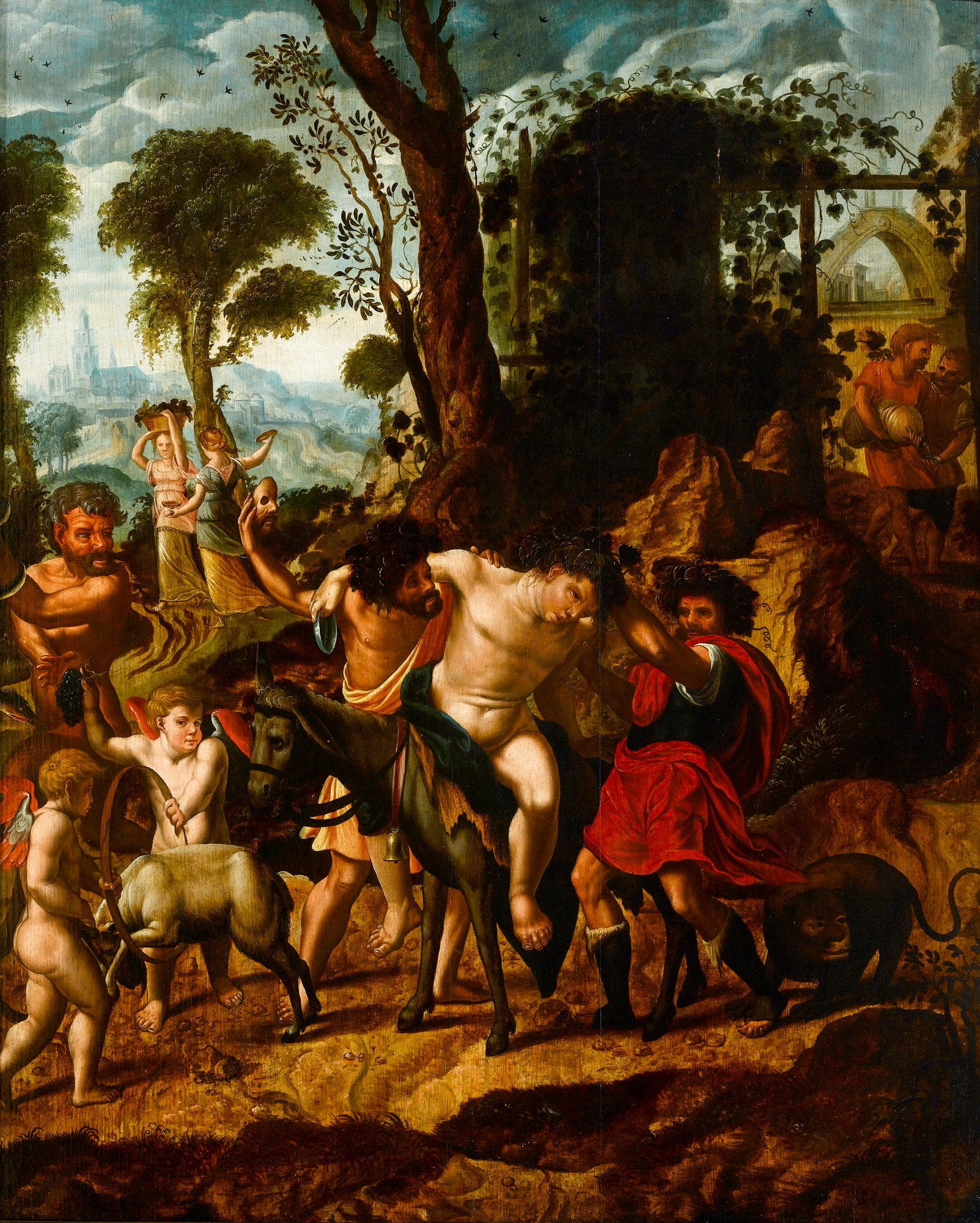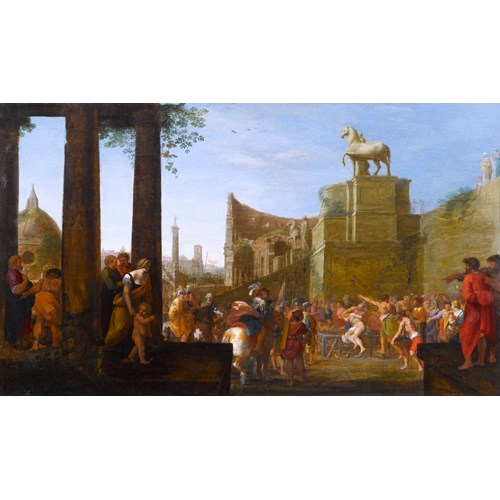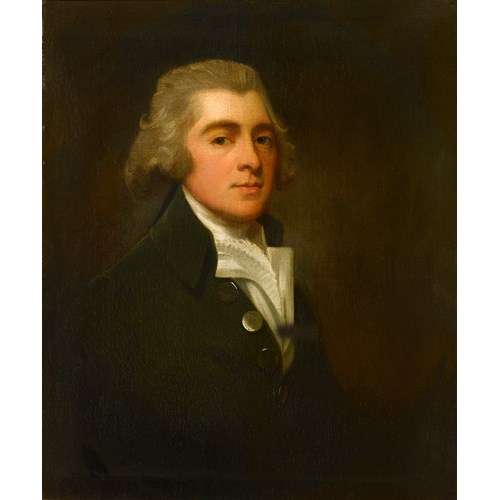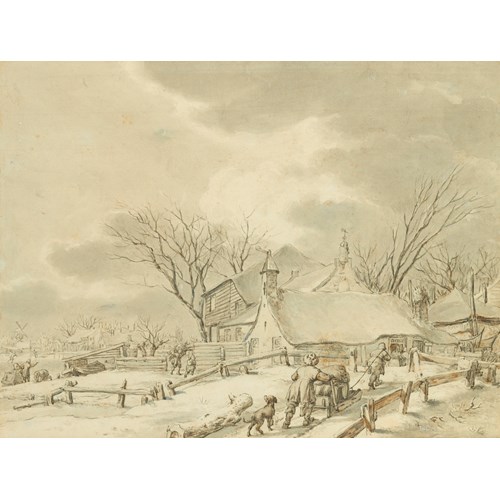Marketplace
The Triumph of Silenus
Jan Swart van Groningen
The Triumph of Silenus
Epoque 1400-1600, 16th Century
Origine Belgium, The Netherlands
Medium Oil on panel
Dimension 83 x 68.4 cm (32⁵/₈ x 26⁷/₈ inches)
In this engrossing example of Northern Mannerist painting, we are presented with a scene of debauched Bacchic revelry. In the centre of the work an overweight and inebriated Silenus, in danger of falling off his donkey, is steadied by two of his attendants, whilst a panther prowls around their feet. The donkey is dutifully following a satyr and two putti, who are encouraging a goat to jump through a circle. Beyond this central grouping are two bacchante, one of whom plays the cymbals, whilst another carries a basket of grapes upon her head. On the right hand side two figures join the celebrations by pouring from a bulging wineskin.
The Triumph of Silenus has been attributed to Jan Swart van Groningen, and another version of the work, also attributed to Swart van Groningen, is housed in the Kunsthistorisches Museum in Vienna. The Triumph of Silenus is slightly larger than the Vienna version, but the compositions are almost identical.¹ Additionally, the treatment of the figures is extremely similar, to the extent that it seems plausible that they are by the same hand.
The composition of The Triumph of Silenus, derives from an engraving of the same subject by Agostino Veneziano (c. 1490–after 1536), which was after a drawing by either Raphael (1483-1520) or Giulio Romano (1499-1546).² Swart has developed the composition of Veneziano’s print, using a portrait format and including a greater element of landscape, in the slightly fantastical Flemish tradition. There is a greater sense of depth in the arrangement of the figures, so that individual groupings are more clearly separated and defined. However, many of the figures in Swart’s work are closely based on their Italian prototypes. For example on the left hand side there is the same bearded satyr, crossing his arms and looking back over his shoulder at Silenus. However, in the engraving he helps hold the hoop through which the goat jumps, whilst in the painting there is an extra putto holding the ring in one hand whilst handing the satyr a bunch of grapes. This additional putto plays an important compositional role in The Triumph of Silenus, as his very direct gaze engages the viewer, making them feel complicit in the drunken revelry. In both works, the central grouping is very similarly composed, with Silenus falling from his ass supported by two attendants, although the figural types are very different; Silenus in particular is much younger in Swart’s painting. Whichever of Raphael or Giulio Romano designed the print, it is thought that this central grouping, along with several other of the figures, were ultimately derived from an ancient Roman sarcophagus that was in Santa Maria Maggiore during the sixteenth century, ‘yet each has been rethought and freely altered’.³
It was common practice in the first half of the sixteenth century for Flemish artists to use Italian works as artistic sources due to the dissemination of these works through engravings. For example in another work attributed to Swart, Adam and Eve in the Garden of Eden, (Private Collection) the central figures derive from an engraving by Marcantonio Raimondi (c.1480 – c.1534), also after Raphael. However, in a manner similar to that employed in The Triumph of Silenus, Swart has cleverly expanded the original composition, placing the muscular contorted figures in an expansive landscape. With the rocky foregrounds, carefully rendered foliage, and mountainous backgrounds, Swart demonstrates an acute interest in depicting the landscape. Swart spent a period of time living in Venice, and perhaps these works reflect the traditional Venetian sensibility to nature.
Swart’s secure oeuvre is limited to woodcuts and stained glass, and so although a number of panel paintings have been attributed to him on stylistic grounds, the authorship of these are at this time uncertain. However, The Triumph of Silenus certainly seems to be stylistically consistent with this tentative oeuvre. The Groninger Museums The Feeding of the Five Thousand, has the same rich colours as The Triumph of Silenus, where the deep red of some of some of the figures’ cloaks, give prominence to certain areas of the picture, and contrast against the mellower blues and greens of the backgrounds. Compositionally the central figures of Silenus and Christ, are respectively flanked by two attendants as they move laterally through the compositions. In both cases the composition is divided by a strong vertical, on one side of which the view extends as far as the middle ground, whereas on the other it reveals an expansive background. In both works Swart has used the device of a figure placed at the edge of the panel to directly meet the gaze of the viewer, and engage them with the scene. Additionally many of the figure types are similar, despite the very different subject matter in the work. The putti and the children in each work are very similar, and the awkward jerk of the head by one of the apostles accompanying Christ, is reminiscent of the pose of the satyr in The Triumph of Bacchus.
In addition to the Italian influence that can be discerned in Swart’s work, The Triumph of Silenus also demonstrates the influence of Swart’s Flemish contemporaries, such as Jan van Scorel (1495-1562). Van Scorel was one of the first North Netherlandish artists to visit Italy and his fusion of Northern and Italian styles was extremely influential to a number of artists including Swart. In van Scorel’s The Baptism of Christ, (Frans Hals Museum, Haarlem) there is the same integration of landscape into the crowded narrative that is such a feature of The Triumph of Silenus. Van Scorel shows a similar interest in the nude, and his figures are not only divided into very clear groupings, but each seems individualised, with many in contorted or odd poses. These are features which are of course very much in evidence in Swart’s work.
Very little is known of Swart’s life, one of the reasons why reconstructing his oeuvre has proved so problematic to scholars. The great biographer of early Northern painting, Karel van Mander (1548-1606) records that Swart probably spent several years in Gouda, probably in the early 1520s, where he was the teacher of Adriaen Pietersz. Crabeth (d. 1553). He also lived in Venice and the influence of the Italian Renaissance seems to have had a major impact on his art. In particular his work seems to suggest knowledge of Raphael and his school. It also seems he travelled from Venice to Constantinople, where he depicted Sultan Süleyman the Great (1494-1566) and his entourage. Swart is also thought to have lived in Antwerp from c. 1524-1528, and his work is clearly stylistically linked with artists of that city.
As already mentioned the works firmly attributed to Swart are woodcuts and stained glass, which also display Italianate figure types in complex poses, set within prominent landscapes. Even van Mander admits to never having seen any of Swart’s paintings but says that he painted ‘landscapes, nudes and figures’ close in style to van Scorel, and that he was ‘one of the glories of our school’. Although at this time it is not possible to firmly attribute The Triumph of Silenus, it is clear that it is consistent in style and quality with the tentative ouevre already assembled by scholars.
¹ The Kunsthistorisches Museum’s version measures 77 x 65 cm., compared to the present work, which measures 83 x 68.4 cm.
² The Kunsthistoriches Museum’s version of the present work was first recorded in 1659, in collection of Archduke Leopold Wilhelm of Austria (1614-1662), as being by Giulio Romano.
³ Thompson, W., ‘Poets, Lovers, and Heroes in Italian Mythological Prints’, in The Metropolitan Museum of Art Bulletin, vol. 61, no. 3 (Winter 2004), p.28.
The Triumph of Silenus has been attributed to Jan Swart van Groningen, and another version of the work, also attributed to Swart van Groningen, is housed in the Kunsthistorisches Museum in Vienna. The Triumph of Silenus is slightly larger than the Vienna version, but the compositions are almost identical.¹ Additionally, the treatment of the figures is extremely similar, to the extent that it seems plausible that they are by the same hand.
The composition of The Triumph of Silenus, derives from an engraving of the same subject by Agostino Veneziano (c. 1490–after 1536), which was after a drawing by either Raphael (1483-1520) or Giulio Romano (1499-1546).² Swart has developed the composition of Veneziano’s print, using a portrait format and including a greater element of landscape, in the slightly fantastical Flemish tradition. There is a greater sense of depth in the arrangement of the figures, so that individual groupings are more clearly separated and defined. However, many of the figures in Swart’s work are closely based on their Italian prototypes. For example on the left hand side there is the same bearded satyr, crossing his arms and looking back over his shoulder at Silenus. However, in the engraving he helps hold the hoop through which the goat jumps, whilst in the painting there is an extra putto holding the ring in one hand whilst handing the satyr a bunch of grapes. This additional putto plays an important compositional role in The Triumph of Silenus, as his very direct gaze engages the viewer, making them feel complicit in the drunken revelry. In both works, the central grouping is very similarly composed, with Silenus falling from his ass supported by two attendants, although the figural types are very different; Silenus in particular is much younger in Swart’s painting. Whichever of Raphael or Giulio Romano designed the print, it is thought that this central grouping, along with several other of the figures, were ultimately derived from an ancient Roman sarcophagus that was in Santa Maria Maggiore during the sixteenth century, ‘yet each has been rethought and freely altered’.³
It was common practice in the first half of the sixteenth century for Flemish artists to use Italian works as artistic sources due to the dissemination of these works through engravings. For example in another work attributed to Swart, Adam and Eve in the Garden of Eden, (Private Collection) the central figures derive from an engraving by Marcantonio Raimondi (c.1480 – c.1534), also after Raphael. However, in a manner similar to that employed in The Triumph of Silenus, Swart has cleverly expanded the original composition, placing the muscular contorted figures in an expansive landscape. With the rocky foregrounds, carefully rendered foliage, and mountainous backgrounds, Swart demonstrates an acute interest in depicting the landscape. Swart spent a period of time living in Venice, and perhaps these works reflect the traditional Venetian sensibility to nature.
Swart’s secure oeuvre is limited to woodcuts and stained glass, and so although a number of panel paintings have been attributed to him on stylistic grounds, the authorship of these are at this time uncertain. However, The Triumph of Silenus certainly seems to be stylistically consistent with this tentative oeuvre. The Groninger Museums The Feeding of the Five Thousand, has the same rich colours as The Triumph of Silenus, where the deep red of some of some of the figures’ cloaks, give prominence to certain areas of the picture, and contrast against the mellower blues and greens of the backgrounds. Compositionally the central figures of Silenus and Christ, are respectively flanked by two attendants as they move laterally through the compositions. In both cases the composition is divided by a strong vertical, on one side of which the view extends as far as the middle ground, whereas on the other it reveals an expansive background. In both works Swart has used the device of a figure placed at the edge of the panel to directly meet the gaze of the viewer, and engage them with the scene. Additionally many of the figure types are similar, despite the very different subject matter in the work. The putti and the children in each work are very similar, and the awkward jerk of the head by one of the apostles accompanying Christ, is reminiscent of the pose of the satyr in The Triumph of Bacchus.
In addition to the Italian influence that can be discerned in Swart’s work, The Triumph of Silenus also demonstrates the influence of Swart’s Flemish contemporaries, such as Jan van Scorel (1495-1562). Van Scorel was one of the first North Netherlandish artists to visit Italy and his fusion of Northern and Italian styles was extremely influential to a number of artists including Swart. In van Scorel’s The Baptism of Christ, (Frans Hals Museum, Haarlem) there is the same integration of landscape into the crowded narrative that is such a feature of The Triumph of Silenus. Van Scorel shows a similar interest in the nude, and his figures are not only divided into very clear groupings, but each seems individualised, with many in contorted or odd poses. These are features which are of course very much in evidence in Swart’s work.
Very little is known of Swart’s life, one of the reasons why reconstructing his oeuvre has proved so problematic to scholars. The great biographer of early Northern painting, Karel van Mander (1548-1606) records that Swart probably spent several years in Gouda, probably in the early 1520s, where he was the teacher of Adriaen Pietersz. Crabeth (d. 1553). He also lived in Venice and the influence of the Italian Renaissance seems to have had a major impact on his art. In particular his work seems to suggest knowledge of Raphael and his school. It also seems he travelled from Venice to Constantinople, where he depicted Sultan Süleyman the Great (1494-1566) and his entourage. Swart is also thought to have lived in Antwerp from c. 1524-1528, and his work is clearly stylistically linked with artists of that city.
As already mentioned the works firmly attributed to Swart are woodcuts and stained glass, which also display Italianate figure types in complex poses, set within prominent landscapes. Even van Mander admits to never having seen any of Swart’s paintings but says that he painted ‘landscapes, nudes and figures’ close in style to van Scorel, and that he was ‘one of the glories of our school’. Although at this time it is not possible to firmly attribute The Triumph of Silenus, it is clear that it is consistent in style and quality with the tentative ouevre already assembled by scholars.
¹ The Kunsthistorisches Museum’s version measures 77 x 65 cm., compared to the present work, which measures 83 x 68.4 cm.
² The Kunsthistoriches Museum’s version of the present work was first recorded in 1659, in collection of Archduke Leopold Wilhelm of Austria (1614-1662), as being by Giulio Romano.
³ Thompson, W., ‘Poets, Lovers, and Heroes in Italian Mythological Prints’, in The Metropolitan Museum of Art Bulletin, vol. 61, no. 3 (Winter 2004), p.28.
Epoque: 1400-1600, 16th Century
Origine: Belgium, The Netherlands
Medium: Oil on panel
Dimension: 83 x 68.4 cm (32⁵/₈ x 26⁷/₈ inches)
Plus d'œuvres d'art de la Galerie









_T638803087933826238.jpg?width=500&height=500&mode=pad&scale=both&qlt=90&format=jpg)